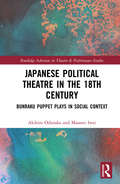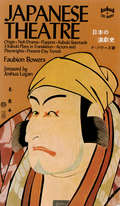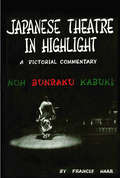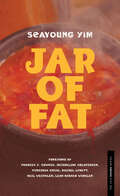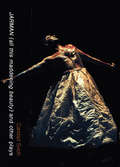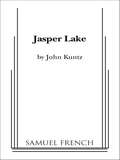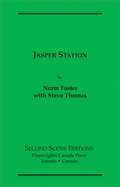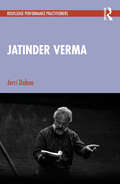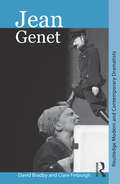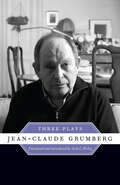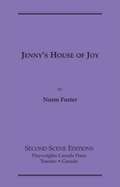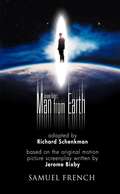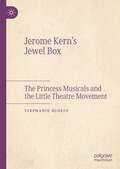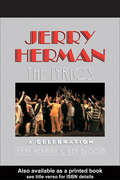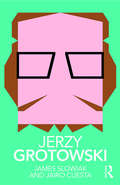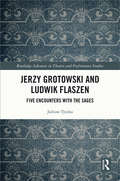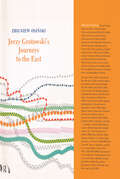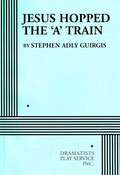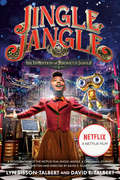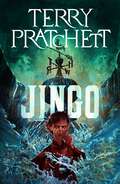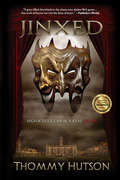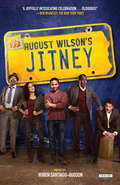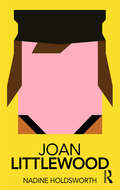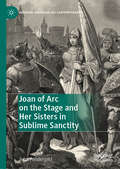- Table View
- List View
Japanese Political Theatre in the 18th Century: Bunraku Puppet Plays in Social Context (Routledge Advances in Theatre & Performance Studies)
by Akihiro Odanaka Masami IwaiBunraku has fascinated theatre practitioners through its particular forms of staging, such as highly elaborated manipulation of puppets and exquisite coordination of chanters and shamisen players. However, Bunraku lacks scholarship dedicated to translating not only the language but also cultural barriers of this work. In this book, Odanaka and Iwai tackle the wealth of bunraku plays underrepresented in English through rexamining their siginifcance on a global scale. Little is written on the fact that bunraku theatre, despites its elegant figures of puppets and exotic stories, was often made as a place to manifest the political concerns of playwrights in the 18th century, hence a reflection of the audience's expectation that could not have materialized outside the theatre. Japanese Political Theatre in the 18th Century aims to make bunraku texts readable for those who are interested in the political and cultural implications of this revered theatre tradition.
Japanese Theatre
by Joshua Logan Faubion BowersJapanese Theatre, by Faubion Bowers, presents a full historical account for Westerners of the theatre arts that have flourished for centuries in Japan. "This book," say Mr. Bowers, "is a survey of what theatre arts exist there today and how they arose. Because Kabuki is the dominant type of drama in Japan today, and has been for three centuries, I have given most attention to it."This book, with its many excellent photographs, is a permanent addition to the West's knowledge of the exotic, exciting theatre of Japan and its tradition of great acting.
Japanese Theatre in Highlight: A Pictorial Commentary
by Faubion Bowers Earle Ernst Francis HaarWords cannot explain to an outsider the sight and feel of the Japanese stage. And definitions and descriptions do not convey an exact image to people brought up on a concept of the theatre that differs so greatly from the Japanese as ours. In seeing something foreign, too, our eyes must be guided carefully, so that we know what we are seeing and how to look at it profitably. All of us are to be grateful for this book, because now, without leaving our contries, or for that matter our armchairs, we can peer at leisure into expertly selected, edited and glossed highlights of the three great classical theatre arts of Japan-Noh, Bunraku and Kabuki. The Fifty-four ensuing photgraphs, with their textual commentary, are the equivalent, in my mind, of fifty-four choice seats at some of the best performances in modern Japan and intimate visits backstage.
Jar of Fat (Yale Drama Series)
by Seayoung YimAn absurdist comedy and fifteenth winner of the Yale Drama Prize, exploring family, religion, identity, desire, and beauty in Korean American culture In a fantastical fairy-tale world, two Korean American sisters are deemed too fat to fit in their family grave. Will the sisters’ close bond survive under the pressure of their community and fretful parents, who will spare no effort to make them tinier? Jar of Fat, the fifteenth winner of the Yale Drama Prize, is a phantasmagorical, absurdist Korean American tale about the allure and danger entangled within the quest for beauty and thinness. Both laugh-out-loud funny and deeply troubling, Seayoung Yim’s play burns through the accumulated rage that anti-fat bias produces to reclaim what it steals from us every day: grace, space, possibility, and breath.
Jarman (all this maddening beauty) and other plays
by Caridad Svich“JARMAN (all this maddening beauty”) and Other Plays is a collection of three radically poetic works for live performance by OBIE Award–winning playwright Caridad Svich. The playtexts includes a lyrical meditation on the legacy of iconic queer artist Derek Jarman, a meditation on displacement and human suffering (Carthage/Cartagena), and an intimately operatic reflection on Penelope and Odysseus (The Orphan Sea). Accompanied by scholarly essays placing the plays in context, this book showcases the beautiful strangeness and profound resistance in Svich’s work.
Jasper Lake
by John KuntzFull Length, Drama \ 4m, 4f \ Unit Set \ Haunted by a violent past, Liz Sloane awakens to the voice of a girl she has never met, beckoning her to a place called Jasper Lake. Two affluent families reside along this beautiful, exclusive body of water: The abusive Mitchell, his long-suffering wife Nora and her teen-age daughter, Jennifer. Next door is loquacious Mid-western new-comer Deb, her workaholic husband Jerry and their disturbed son Caleb. A "meet the new neighbors" party ensues that will change these families forever, as their secrets and betrayals bubble to the surface. Someone will drown in Jasper Lake tonight, unless Liz and her new boyfriend, an unemployed roadie named Drake, can make it there in time. \ "JASPER LAKE sparkles with a haunting allure...every moment of mystery, fear, shock and dismay touches the audience the way a stone tossed in a pond creates an unmistakable ripple."-Boston Herald
Jasper Station
by Norm FosterSix travellers wait in a train station in Jasper, Alberta, hoping to fulfill their dreams at the other end of the line.
Jatinder Verma (Routledge Performance Practitioners)
by Jerri DabooJatinder Verma has been a pioneering figure in the development of British South Asian theatre, and a prominent spokesperson for the importance of increased diversity amongst playwrights, actors, directors, designers, and producers on the mainstream British stage. As co-founder and former Artistic Director of Tara Arts, he developed a new aesthetic style known as 'Binglish' which creates a hybrid dramaturgy of languages, training and performance forms, and styles of acting, and design, that operates to establish a negotiation between cultures which reflects contemporary Britain. Verma is acknowledged as being a leading practitioner and director, as well as writer about theatre and culture, who has transformed the face of theatre in Britain and internationally.This book combines:• a detailed biography giving the social and artistic context of Verma’s work and his work with Tara Arts;• an exploration of Verma’s own writings on ‘Binglish’, including his use of a range of performance forms and philosophies from different cultures, such as the importance of the Natyashastra in his thinking and practice;• a stylistic analysis of his key productions, including Tartuffe, The Merchant of Venice, Macbeth, and the Bollywood pantomimes;• pathways into some of the practical exercises relating to the dramaturgical style of ‘Binglish’ devised by Jatinder Verma.As a first step towards critical understanding, and as an initial exploration before going on to further, primary research, Routledge Performance Practitioners offer unbeatable value for today’s student.
Jean Genet: Performance And Politics (Routledge Modern and Contemporary Dramatists)
by David Bradby Claire FinburghThis book is the only introductory text to Genet in English, offering an overview of this key figure in defining and understanding twentieth-century theatre. The authors provide a comprehensive account of Genet's key plays and productions, his early life and his writing for and beyond the theatre.
Jean-Claude Grumberg: Three Plays (Exploring Jewish Arts and Culture)
by Jean-Claude GrumbergWinner of seven Molières, the Pulitzer Prize of France, Jean-Claude Grumberg is one of France&’s leading dramatists and a distinguished voice of modern European Jewry after the Shoah. His success in portraying contemporary Parisian Jews on the stage represents a new development in European theater and a new aesthetic expression of European Jewish experience and sensibility of the Holocaust and its aftermath, a perspective quite different from either the American or the Israeli one. Grumberg&’s Jews are French to their fingertips, yet they have been made more consciously Jewish by the war and the difficulties of reintegrating into a society in which too many neighbors denounced them or ignored their pleas to save their children. Affirming the new status of Jewish culture, Grumberg&’s plays insist on the recognition of Jewish identity and uniqueness within the majority societies of Europe. This volume offers the first English translation of three of Grumberg&’s prize-winning plays: The Workplace (L&’Atelier, 1979), On the Way to the Promised Land (Vers toi Terre promise, 2006) and Mama&’s Coming Back, Poor Orphan (Maman revient, pauvre orphelin, 1994). Presented in the order of the history they record and steeped in Grumberg&’s personal experience and insights into contemporary Parisian life, these plays serve as documentary witnesses that begin with the immediate postwar reality and continue up to the end of the twentieth century. Seth Wolitz provides notes on the plays&’ themes, structures, characters, and settings, along with an introduction that discusses Grumberg&’s place within the emergence of French-Jewish drama and a translation of an interview with the playwright himself.
Jenny's House of Joy
by Norm FosterWhen a tireless young runaway comes begging for a job, the girls at Jenny's house might just have to leave their lingerie behind. A delightful new comedy about the oldest profession.
Jerome Bixby's The Man from Earth
by Richard SchenkmanRichard Schenkman / 6m, 3f / Drama / Unit Set / After history professor John Oldman unexpectedly resigns from the University, his startled colleagues impulsively invite themselves to his home, pressing him for an explanation. But they're shocked to hear his reason for premature retirement: John claims he must move on because he is immortal, and cannot stay in one place for more than ten years without his secret being discovered. Tempers rise and emotions flow as John's fellow professors attempt to poke holes in his story, but it soon becomes clear that his tale is as impossible to disprove as it is to verify. What starts out as a friendly gathering soon builds to an unexpected and shattering climax. Acclaimed science fiction writer Jerome Bixby, writer of the original 'Star Trek' and 'The Twilight Zone', originally conceived this story back in the early 1960's. It would come to be his last great work.
Jerome Kern’s Jewel Box: The Princess Musicals and the Little Theatre Movement
by Stephanie RuozzoJerome Kern’s Jewel Box shows how the integration of spoken and sung performances in Kern's early musicals reveals new connections between musical theater scores and “straight” (spoken) theater. Kern’s scores are foundational to the American musical, and subsequent dramatic music would be unrecognizable without Kern’s innovations. This book argues that Kern’s scores for a group of musicals staged at the Princess Theatre embody a musical corollary to the Realist drama of the Little Theatre Movement. The umbrella term “Princess musicals” includes the four musicals that Jerome Kern composed for New York City’s Princess Theatre: Nobody Home (1915), Very Good Eddie (also 1915), Oh, Boy! (1917), and Oh, Lady! Lady!! (1918), as well as Leave It to Jane (1917), a musical conceived for the Princess. Each separate Princess musical bears distinct hallmarks of Little Theatre sensibility, and that these hallmarks are overwhelmingly represented in the sung/musical portions of the drama. The book’s first chapter explores the influences of WWI and the Little Theatre Movement on the American stage (legitimate and musical). The subsequent chapters are studies of the five so-called “intimate musical comedies” that resulted from Kern’s engagement with these influences. The case studies all demonstrate how the shows’ scores advance the same artistic aims voiced by prominent members of the Little Theatre Movement. Ultimately, this project leads musical theater historians to reconsider the place of musicals in relation to the legitimate theatre and the historiography we construct around the “integrated” musical.
Jerry Herman: The Lyrics
by Ken Bloom Jerry HermanJerry Herman is one of Broadway's most celebrated composers and lyricists, this book includes early lyrics from Herman's first Broadway revues and shows, songs cut from his best-loved shows, and new lyrics.
Jerzy Grotowski (Routledge Performance Practitioners)
by James Slowiak Jairo CuestaMaster director, teacher, and theorist, Jerzy Grotowski’s work extended well beyond the conventional limits of performance. Now revised and reissued, this book combines: ● an overview of Grotowski’s life and the distinct phases of his work ● an analysis of his key ideas ● a consideration of his role as director of the renowned Polish Laboratory Theatre ● a series of practical exercises offering an introduction to the principles underlying Grotowski’s working methods. As a first step towards critical understanding, and an initial exploration before going on to further, primary research, Routledge Performance Practitioners offer unbeatable value for today’s student.
Jerzy Grotowski and Ludwik Flaszen: Five Encounters with the Sages (Routledge Advances in Theatre & Performance Studies)
by Juliusz TyszkaThe book contains three accounts of five public speeches and conversations with the public of two outstanding figures of theatre and performance, Jerzy Grotowski and Ludwik Flaszen, from 1993 to 1997. Their speeches concern their output and their current research. The content of Ludwik Flaszen's speech is very closely related to the output of Jerzy Grotowski. The accounts are written on the base of the author's detailed notes. The main subject of these narratives is their author, who quotes the speaking characters in the third person. In this way, all texts acquire a subjective character, akin to an essay, while remaining faithful to the overall message and content of the speeches and conversations cited in them. Juliusz Tyszka also uses this form of narration to describe the interpersonal context of Flaszen’s and Grotowski’s talks, including the content and tone of the questions asked, the reactions of listeners, etc. There is also room for short, concise characteristics of these two outstanding people and their interlocutors (who are themselves sometimes also notorious). This book will be of great interest to scholars and students of theatre and performance studies and professionals in experimental theatre and performance.
Jerzy Grotowski's Journeys to the East
by Zbigniew OsinskiJerzy Grotowski’s Journeys to the East is an unusual collection of facts, quotations, and commentaries documenting the real and metaphorical journeys of the Polish theatre director and ‘teacher of performers’ into a geographical and cultural dimension which we used to and still call the Orient. Grotowski’s contacts and meetings with the East are placed here in the context of his biography. Painstakingly researched by Grotowski’s main biographer Zbigniew Osiński, this book is necessary reading for those interested in Grotowski’s deep relationship with the East and in the inspiration he drew from its various cultures. The book will appeal to all readers who feel a need to have a glimpse of the East from the perspective of one of the main theatre reformers in the twentieth century.
Jesus Hopped the A Train
by Stephen Adly Guirgis"Its aggressive high-octane style is like a shot of caffeine straight in the veins" - Lyn Gardner, Guardian Angel Cruz, a poor Puerto Rican, isn't sure why he's in jail after shooting Reverend Kim, the born-again Christian who brainwashed his best friend. 'All I did was shoot him in the ass', he explains to his long-suffering lawyer Mary Hanrahan. But when the Reverend dies in hospital, Angel lands in solitary confinement next to Lucius, a card-carrying Christian serial-killer. Angel holds out that he was justified and his lawyer's sure that a hearts-and-minds appeal will get him off at trial. But then, in a knife-edge final discussion before Lucius is sent to the electric chair, Angel extraordinarily finds that he too is turning towards the faith that he has so far shunned, thus jeopardising his own case against the born-agains. This is a truth-telling, cage-rattling play about faith, justice and diminishing options in an American prison.A 2001 Edinburgh Festival and Off-Broadway hit, the play's London premieres at the Donmar Warehouse in March 2002.
Jingle Jangle: (Movie Tie-In)
by David E. Talbert Lyn Sisson-TalbertA joyful middle grade novel based on the Netflix holiday film Jingle Jangle: A Chistmas Journey, starring Phylicia Rashad, Forrest Whitaker, Anika Noni Rose, Keegan Michael Key, and newcomer Madalen Mills, about an eccentric toymaker, his adventurous granddaughter, and a magical invention, that if they can get it to work in time for the holidays, could change their lives forever.A delightful middle grade story based on the Netflix holiday film Jingle Jangle: A Christmas Journey! A holiday tale set in the snow-covered town of Cobbleton, Jingle Jangle follows eccentric toymaker Jeronicus Jangle (Academy Award winner Forest Whitaker) whose fanciful inventions burst with whimsy and wonder. But when a betrayal by a former protégé (Keegan-Michael Key) leaves Jeronicus withdrawn and down on his luck, it's up to his bright and adventurous granddaughter, Journey (newcomer Madalen Mills) -- and a singularly magical invention -- to save the day. From the imagination of writer/director David E. Talbert and producer Lyn Sisson-Talbert, featuring original music by John Legend, Philip Lawrence, Davy Nathan, and Michael Diskint. Jingle Jangle reminds you that anything is possible...if you believe.
Jingo: A Discworld Novel (City Watch #4)
by Terry Pratchett“Pratchett’s writing is a constant delight. No one mixes the fantastical and the mundane to better comic effect or offers sharper insights into the absurdities of human endeavor.” —Daily MailCommander Sam Vines, the Ankh-Morpork City Watch, and their compatriots must fight for their country (or something like that) when Discworld goes to war in this wickedly funny Discworld novel from New York Times bestselling author Terry Pratchett.No one would dream of starting a war without a perfectly good reason . . . such as a “strategic” piece of old rock in the middle of nowhere known as Leshp. It isn’t much of an island that rises up one moonless night from the depths of the Circle Sea—just a few square miles of silt and some old ruins. Unfortunately, this historically disputed lump of earth is once again floating directly between two proud lands, Ankh-Morpork and the city of Al-Khali on the coast of Klatch. And that’s enough to ignite the inglorious international pastime known as “war.”It is, after all, every citizen’s right to bear arms to defend their own. Even if it isn’t technically their own. And even if they don’t have much in the way of actual weaponry. Pressed into patriotic service, Commander Sam Vimes thinks he should be leading his loyal watchmen, female watchdwarf, and lady werewolf into battle against local malefactors rather than against Klatchians. But war is, after all, simply the greatest of all crimes—and it’s Sir Samuel’s sworn duty to seek out criminal masterminds wherever they may be hiding . . . and lock them away.As two armies march, Vimes faces unpleasant foes who are out to get him . . . and that’s just the people on his side. The enemy might be even worse.The Discworld novels can be read in any order but Jingo is the 4th book in the City Watch collection and the 21st Discworld book.The City Watch series in order:Guards! Guards!Men at ArmsFeet of ClayJingoThe Fifth ElephantNight WatchThud!Snuff
Jinxed (Jinxed Trilogy)
by Thommy HutsonBreak a mirrorWalk under a ladderStep on a crackInnocent childhood superstitions …But someone at the Trask Academy of Performing Arts is taking things one deadly step further when the campus is rocked with the deaths of some of its star students.Layna Curtis, a talented, popular senior, soon realizes that the seemingly random, accidental deaths of her friends aren't random—or accidents—at all. Someone has taken the childhood games too far, using the idea of superstitions to dispose of their classmates. As Layna tries to convince people of her theory, she uncovers the terrifying notion that each escalating, gruesome murder leads closer to its final victim: her.Will Layna's opening night also be her final bow?Gold Medal Winner for Fiction: Horror—2019 International Book Awards
Jitney: A Play - Broadway Tie-In Edition
by August Wilson Ruben Santiago-HudsonRereleased in time for its first Broadway run, Jitney is the seventh in Wilson’s 10-play cycle on the black experience in 20th century America Only one of the plays in two-time Pulitzer Prize winner August Wilson’s masterful The American Century Cycle has never been seen on Broadway—until now. In his preface to this Broadway edition of Jitney, director Ruben Santiago-Hudson writes: “There had been nine jewels placed in August Wilson’s formidable crown, each had changed the landscape of Broadway in their respective seasons. Until now, only one gem was missing. With this production of Jitney at the Manhattan Theatre Club’s Samuel J. Friedman Theatre the final gem is in place.” Set in the 1970s, this richly textured piece follows a group of men trying to eke out a living by driving unlicensed cabs, or jitneys. When the city threatens to board up the business and the boss’s son returns from prison, tempers flare, potent secrets are revealed and the fragile threads binding these people together may come undone at last. In addition to the essential and insightful preface by Ruben Santiago-Hudson, this edition boasts production stills from the Manhattan Theatre Club’s Broadway production, directed by Santiago-Hudson and featuring Harvy Blanks, Anthony Chisholm, Brandon J. Dirden, André Holland, Carra Patterson, Michael Potts, Keith Randolph Smith, Ray Anthony Thomas, and John Douglas Thompson.
Joan Littlewood (Routledge Performance Practitioners)
by Nadine HoldsworthThis book uses original archival material to consider the theatrical and cultural innovations of Joan Littlewood and her company, 'Theatre Workshop'. Littlewood had a huge impact on the way theatre was generated, rehearsed and presented during the twentieth century. Now reissued, Joan Littlewood is the first book to combine: an overview of Littlewood's career in relation to the wider social, political and cultural context an exploration of Littlewood's theatrical influences, approach to actor's training, belief in the creative ensemble, attitude to text, rehearsal methods and use of improvisation a detailed case study of the origins, research, creative process and thinking behind Littlewood's most famous production, Oh What a Lovely War, and an assessment of its impact a series of practical exercises designed to capture and illustrate the key approaches Littlewood used in the rehearsal room. As a first step towards critical understanding, and as an initial exploration before going on to further, primary research, Routledge Performace Practitioners offer unbeatable value for today's student.
Joan of Arc on the Stage and Her Sisters in Sublime Sanctity (Bernard Shaw and His Contemporaries)
by John PendergastThis book examines the figure of Joan of Arc as depicted in stage works of the nineteenth and twentieth centuries, especially those based on or related to Schiller’s 1801 romantic tragedy, Die Jungfrau von Orleans (The Maid of Orleans). The author elucidates Schiller’s appropriation of themes from Euripides’s Iphigenia plays, chiefly the quality of “sublime sanctity,” which transforms Joan’s image from a victim of fate to a warrior-prophet who changes history through sheer force of will. Finding the best-known works of his time about her – Voltaire’s La pucelle d’Orléans and Shakespeare’s Henry VI, part I – utterly dissatisfying, Schiller set out to replace them. Die Jungfrau von Orleans was a smashing success and inspired various subsequent treatments, including Verdi’s opera Giovanna d’Arco and a translation by the father of Russian Romanticism, Vasily Zhukovsky, on which Tchaikovsky based his opera Orleanskaya deva (The Maid of Orleans). In turn, the book’s final chapter examines Shaw’s Saint Joan and finds that the Irish playwright’s vociferous complaints about Schiller’s “romantic flapdoodle” belie a surprising affinity for Schiller’s approach.
Joanna Baillie, Romantic Dramatist: Critical Essays
by Thomas C. CrochunisThis superb collection of new essays offers a unique insight into the work of a leading women dramatist of the Romantic era. Contributors offer: *contextual material for those new to Baillie's work *examinations of the relationships between her plays and the philosophical and scientific writing of the era *discussion of Baillie's theatrical methods *extended interpretations of individual plays. Ending years of neglect of Baillie's crucial work, this volume is essential reading for those working on Romanticism, women's writing, or drama of the late eighteenth and early nineteenth centuries.
